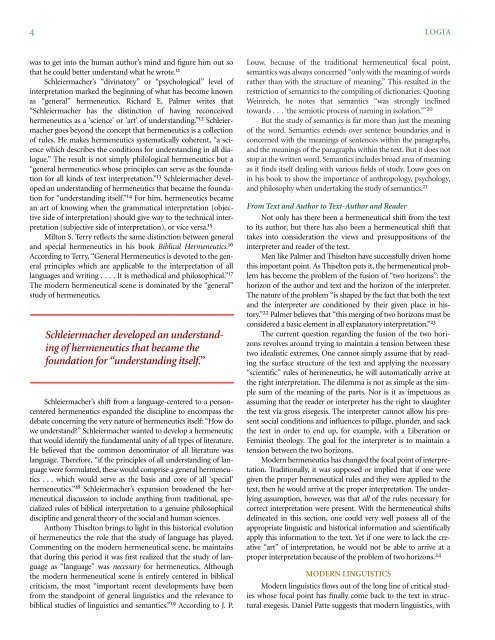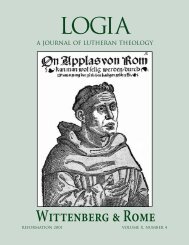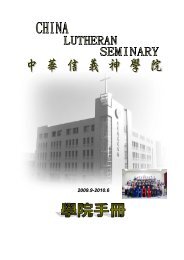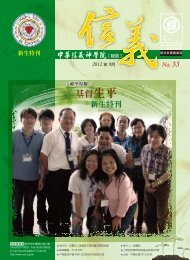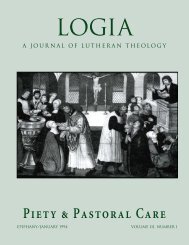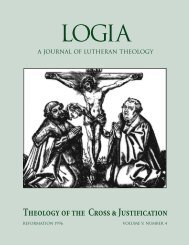04-2 Hermeneutics.pdf
04-2 Hermeneutics.pdf
04-2 Hermeneutics.pdf
- No tags were found...
Create successful ePaper yourself
Turn your PDF publications into a flip-book with our unique Google optimized e-Paper software.
4 LOGIAwas to get into the human author’s mind and figure him out sothat he could better understand what he wrote. 11Schleiermacher’s “divinatory” or “psychological” level ofinterpretation marked the beginning of what has become knownas “general” hermeneutics. Richard E. Palmer writes that“Schleiermacher has the distinction of having reconceivedhermeneutics as a ‘science’ or ‘art’ of understanding.” 12 Schleiermachergoes beyond the concept that hermeneutics is a collectionof rules. He makes hermeneutics systematically coherent, “a sciencewhich describes the conditions for understanding in all dialogue.”The result is not simply philological hermeneutics but a“general hermeneutics whose principles can serve as the foundationfor all kinds of text interpretation.” 13 Schleiermacher developedan understanding of hermeneutics that became the foundationfor “understanding itself.” 14 For him, hermeneutics becamean art of knowing when the grammatical interpretation (objectiveside of interpretation) should give way to the technical interpretation(subjective side of interpretation), or vice versa. 15Milton S. Terry reflects the same distinction between generaland special hermeneutics in his book Biblical <strong>Hermeneutics</strong>. 16According to Terry, “General <strong>Hermeneutics</strong> is devoted to the generalprinciples which are applicable to the interpretation of alllanguages and writing . ... It is methodical and philosophical.” 17The modern hermeneutical scene is dominated by the “general”study of hermeneutics.Schleiermacher developed an understandingof hermeneutics that became thefoundation for “understanding itself.”nbSchleiermacher’s shift from a language-centered to a personcenteredhermeneutics expanded the discipline to encompass thedebate concerning the very nature of hermeneutics itself: “How dowe understand?” Schleiermacher wanted to develop a hermeneuticthat would identify the fundamental unity of all types of literature.He believed that the common denominator of all literature waslanguage. Therefore, “if the principles of all understanding of languagewere formulated, these would comprise a general hermeneutics. . . which would serve as the basis and core of all ‘special’hermeneutics.” 18 Schleiermacher’s expansion broadened the hermeneuticaldiscussion to include anything from traditional, specializedrules of biblical interpretation to a genuine philosophicaldiscipline and general theory of the social and human sciences.Anthony Thiselton brings to light in this historical evolutionof hermeneutics the role that the study of language has played.Commenting on the modern hermeneutical scene, he maintainsthat during this period it was first realized that the study of languageas “language” was necessary for hermeneutics. Althoughthe modern hermeneutical scene is entirely centered in biblicalcriticism, the most “important recent developments have beenfrom the standpoint of general linguistics and the relevance tobiblical studies of linguistics and semantics.” 19 According to J. P.Louw, because of the traditional hermeneutical focal point,semantics was always concerned “only with the meaning of wordsrather than with the structure of meaning.” This resulted in therestriction of semantics to the compiling of dictionaries. QuotingWeinreich, he notes that semantics “was strongly inclinedtowards . . . ‘the semiotic process of naming in isolation.’” 20But the study of semantics is far more than just the meaningof the word. Semantics extends over sentence boundaries and isconcerned with the meanings of sentences within the paragraphs,and the meanings of the paragraphs within the text. But it does notstop at the written word. Semantics includes broad area of meaningas it finds itself dealing with various fields of study. Louw goes onin his book to show the importance of anthropology, psychology,and philosophy when undertaking the study of semantics. 21From Text and Author to Text-Author and ReaderNot only has there been a hermeneutical shift from the textto its author, but there has also been a hermeneutical shift thattakes into consideration the views and presuppositions of theinterpreter and reader of the text.Men like Palmer and Thiselton have successfully driven homethis important point. As Thiselton puts it, the hermeneutical problemhas become the problem of the fusion of “two horizons”: thehorizon of the author and text and the horizon of the interpreter.The nature of the problem “is shaped by the fact that both the textand the interpreter are conditioned by their given place in history.”22 Palmer believes that “this merging of two horizons must beconsidered a basic element in all explanatory interpretation.” 23The current question regarding the fusion of the two horizonsrevolves around trying to maintain a tension between thesetwo idealistic extremes. One cannot simply assume that by readingthe surface structure of the text and applying the necessary“scientific” rules of hermeneutics, he will automatically arrive atthe right interpretation. The dilemma is not as simple as the simplesum of the meaning of the parts. Nor is it as impetuous asassuming that the reader or interpreter has the right to slaughterthe text via gross eisegesis. The interpreter cannot allow his presentsocial conditions and influences to pillage, plunder, and sackthe text in order to end up, for example, with a Liberation orFeminist theology. The goal for the interpreter is to maintain atension between the two horizons.Modern hermeneutics has changed the focal point of interpretation.Traditionally, it was supposed or implied that if one weregiven the proper hermeneutical rules and they were applied to thetext, then he would arrive at the proper interpretation. The underlyingassumption, however, was that all of the rules necessary forcorrect interpretation were present. With the hermeneutical shiftsdelineated in this section, one could very well possess all of theappropriate linguistic and historical information and scientificallyapply this information to the text. Yet if one were to lack the creative“art” of interpretation, he would not be able to arrive at aproper interpretation because of the problem of two horizons. 24MODERN LINGUISTICSModern linguistics flows out of the long line of critical studieswhose focal point has finally come back to the text in structuralexegesis. Daniel Patte suggests that modern linguistics, with


